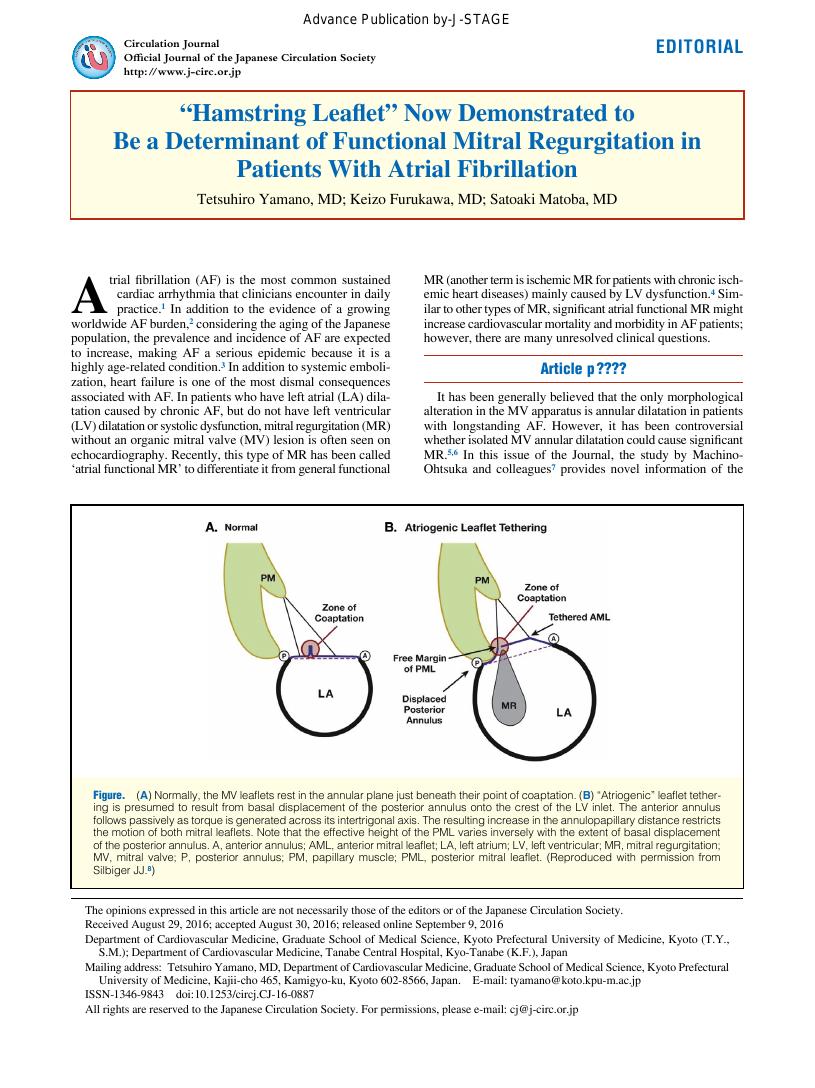- 著者
- Norimasa Taniguchi Takeshi Nakamura Takahisa Sawada Kinya Matsubara Keizo Furukawa Mitsuyoshi Hadase Yoshifumi Nakahara Takashi Nakamura Hiroaki Matsubara
- 出版者
- The Japanese Circulation Society
- 雑誌
- Circulation Journal (ISSN:13469843)
- 巻号頁・発行日
- vol.74, no.11, pp.2365-2371, 2010 (Released:2010-10-25)
- 参考文献数
- 37
- 被引用文献数
- 52 63
Background: Erythropoietin (EPO) enhances re-endothelialization and anti-apoptotic action. Larger clinical studies to examine the effects of high-dose EPO are in progress in patients with acute myocardial infarction (AMI). Methods and Results: The aim of this multi-center pilot study was to investigate the effect of `low-dose EPO' (6,000 IU during percutaneous coronary intervention (PCI), 24 h and 48 h) in 35 patients with a first ST-elevated AMI undergoing PCI who was randomly assigned to EPO or placebo (saline) treatment. Neointimal volume, cardiac function and infarct size were examined in the acute phase and 6 months later (ClinicalTrials.gov identifier: NCT00423020). No significant regression in in-stent neointimal volume was observed, whereas left ventricular (LV) ejection fraction was significantly improved (49.2% to 55.7%, P=0.003) and LV end-systolic volume was decreased in the EPO group (47.7 ml to 39.0 ml, P=0.036). LV end-diastolic volume tended to be reduced from 90.2% to 84.5% (P=0.159), whereas in the control group it was inversely increased (91.7% to 93.7%, P=0.385). Infarction sizes were significantly reduced by 38.5% (P=0.003) but not in the control group (23.7%, P=0.051). Hemoglobin, peak creatine kinase values, and CD34+/CD133+/CD45dim endothelial progenitors showed no significant changes. No adverse events were observed during study periods. Conclusions: This is a first study demonstrating that short-term `low-dose' EPO to PCI-treated AMI patients did not prevent neointimal hyperplasia but rather improved cardiac function and infarct size without any clinical adverse effects. (Circ J 2010; 74: 2365-2371)
- 著者
- Tetsuhiro Yamano Keizo Furukawa Satoaki Matoba
- 出版者
- The Japanese Circulation Society
- 雑誌
- Circulation Journal (ISSN:13469843)
- 巻号頁・発行日
- pp.CJ-16-0887, (Released:2016-09-09)
- 参考文献数
- 14
- 被引用文献数
- 5 7
- 著者
- Jun Shiraishi Yoshio Kohno Takeshi Nakamura Takashi Yanagiuchi Sho Hashimoto Daisuke Ito Masayoshi Kimura Akihiro Matsui Hirokazu Yokoi Masayasu Arihara Masayuki Hyogo Takatomo Shima Takahisa Sawada Satoaki Matoba Hiroyuki Yamada Akiyoshi Matsumuro Takeshi Shirayama Makoto Kitamura Keizo Furukawa on Behalf of the AMI-Kyoto Multi-Center Risk Study Group
- 出版者
- 一般社団法人 日本内科学会
- 雑誌
- Internal Medicine (ISSN:09182918)
- 巻号頁・発行日
- vol.53, no.9, pp.933-939, 2014 (Released:2014-05-01)
- 参考文献数
- 27
- 被引用文献数
- 2 17
Objective The predictors of in-hospital outcomes after primary percutaneous coronary intervention (PCI) for acute myocardial infarction (AMI) complicated with heart failure or cardiogenic shock at presentation remain unclear. Methods Using the AMI-Kyoto Multi-Center Risk Study database, the clinical background characteristics, angiographic findings, primary PCI results, and in-hospital prognoses were retrospectively compared between primary PCI-treated AMI patients with a Killip class status of ≥2 (Killip 2-4 patients, n=390) and those with a Killip class 1 status (Killip 1 patients, n=1,057). Results The Killip 2-4 patients were more likely to have a higher age and proportion of women and exhibited a higher prevalence of previous myocardial infarction, diabetes mellitus and chronic kidney disease or anemia on admission, lower systolic blood pressure (SBP) values on admission, a higher rate of multivessels or left main trunk as the culprit artery, a larger number of diseased vessels, a lower Thrombolysis In Myocardial Infarction (TIMI) grade in the infarct-related artery (IRA) before/after primary PCI and a significantly higher in-hospital mortality rate than the Killip 1 patients. According to a multivariate analysis, age was found to be an independent positive predictor of in-hospital mortality, while admission SBP was an independent positive predictor of in-hospital survival in both groups. In contrast, anemia on admission was found to be an independent predictor of in-hospital death, while the TIMI 3 flow in the IRA after PCI was found to be an independent factor for survival in the Killip 2-4 patients, but not the Killip 1 patients. Conclusion Anemia on admission and the final TIMI 3 flow in the IRA are critical determinants of in-hospital death in AMI patients with a Killip class status of ≥2 undergoing primary PCI.
